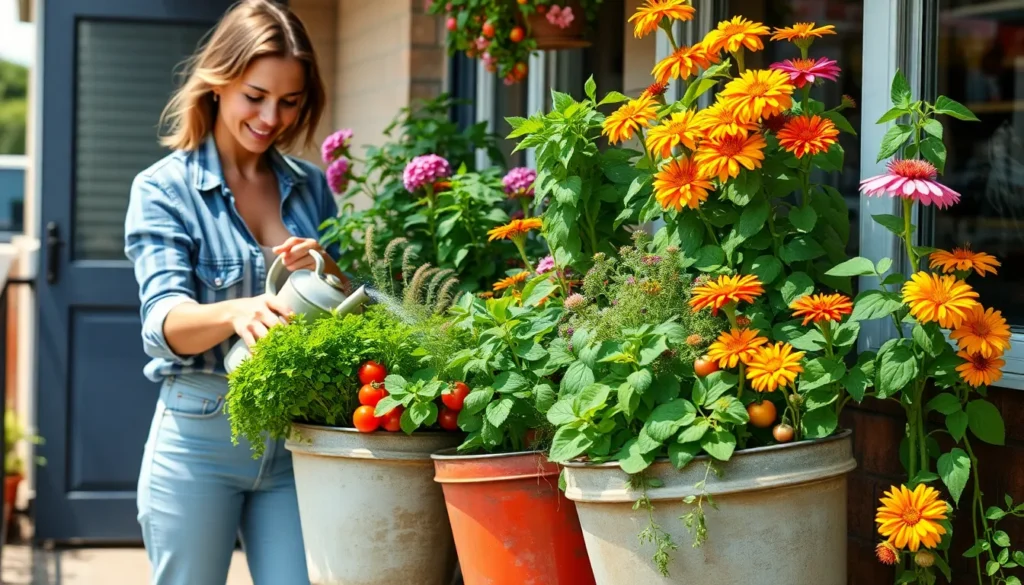We’ve all dreamed of having a thriving garden but felt limited by space, soil quality, or budget constraints. That’s where bucket gardening comes to the rescue – transforming ordinary containers into productive growing spaces that’ll surprise you with their potential.
Bucket gardens offer incredible versatility whether you’re working with a tiny balcony, concrete patio, or even indoor spaces. You can grow everything from fresh herbs and leafy greens to tomatoes and peppers, all while maintaining complete control over soil quality and drainage. Plus, these portable gardens move with you when needed and cost a fraction of traditional raised beds.
We’re about to show you creative bucket garden ideas that’ll maximize your growing space and yield impressive harvests. From choosing the right containers to selecting perfect plant combinations, you’ll discover how simple it is to create your own productive mini-farm using nothing more than buckets and basic gardening supplies.
Transform Old Buckets Into Thriving Herb Gardens
Converting discarded buckets into productive herb gardens offers an excellent way to repurpose containers while creating fresh ingredient sources for your kitchen. We’ll guide you through selecting the right containers and setting up systems that ensure your herbs thrive in their new homes.
Choose the Right Bucket Size for Your Herbs
Large herbs like rosemary and sage need 5-gallon buckets to accommodate their extensive root systems. These woody perennials develop deep taproots that require substantial growing space to flourish. We recommend using food-grade plastic buckets when possible, as they’re safer for edible plants and resist cracking in temperature fluctuations.
Medium-sized herbs such as basil and oregano thrive in 3-gallon containers. These popular culinary herbs produce abundant harvests without overwhelming smaller spaces. Plastic buckets work exceptionally well for these varieties because they retain moisture while remaining lightweight enough to move when needed.
Compact herbs like thyme and chives grow successfully in 1-2 gallon buckets. These smaller varieties don’t require extensive root space and actually prefer slightly confined growing conditions. Metal buckets can work for these herbs if you ensure proper drainage and monitor soil temperature during hot weather.
Select Fast-Growing Herbs for Quick Results
Basil provides harvests within 3-4 weeks from seed and continues producing throughout the growing season. This aromatic herb loves warm conditions and produces continuously when you pinch flowers to encourage leaf growth. We suggest starting with ‘Genovese’ or ‘Sweet Basil’ varieties for reliable results in bucket gardens.
Cilantro reaches harvestable size in just 2-3 weeks and self-seeds readily for continuous crops. This cool-season herb grows quickly in spring and fall temperatures, making it perfect for succession planting. Plant new seeds every 2 weeks to maintain a steady supply of fresh leaves.
Chives emerge within 10-14 days and provide year-round harvests once established. These perennial herbs tolerate various growing conditions and actually improve with regular cutting. We recommend dividing established clumps every 2-3 years to maintain vigorous growth and fill additional buckets.
Create Proper Drainage Systems
Drill 4-6 holes in the bottom of each bucket using a 1/2-inch drill bit for optimal water flow. Proper drainage prevents root rot and ensures healthy plant development in container gardens. Space holes evenly across the bottom surface to allow water to exit from multiple points.
Add a 2-inch layer of gravel or broken pottery pieces before filling with potting soil. This drainage layer prevents soil from washing through the holes while allowing excess water to escape freely. We use pea gravel because it’s inexpensive and provides excellent drainage without adding excessive weight.
Elevate buckets on bricks or plant stands to improve air circulation and drainage efficiency. Raising containers off the ground prevents water pooling and reduces pest problems that develop in stagnant moisture. This simple step significantly improves plant health and reduces maintenance requirements for your herb garden.
Build Vertical Bucket Gardens for Small Spaces
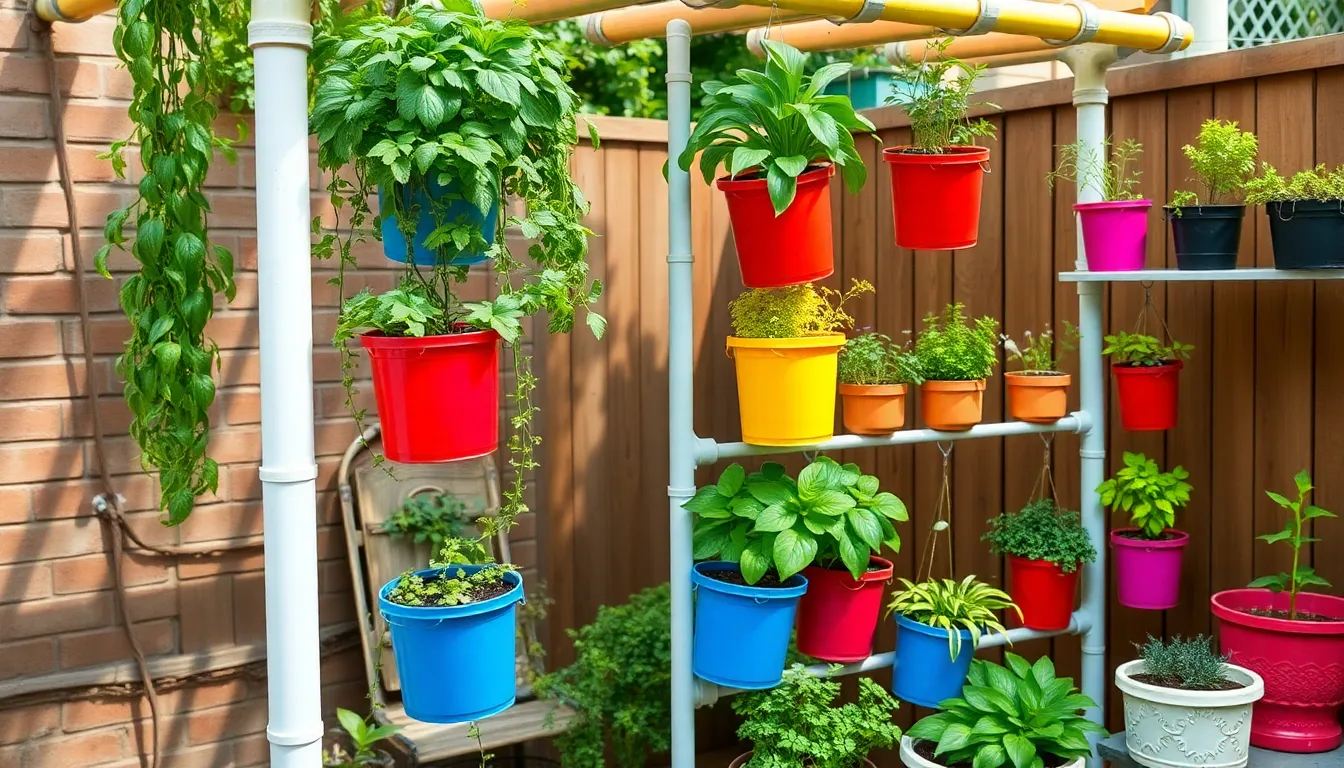
Building upward transforms limited spaces into productive growing areas. We’ll show you three proven methods that maximize your harvest potential while keeping your bucket garden organized and accessible.
Stack Buckets Using PVC Pipe Systems
PVC pipes create the strongest foundation for stacked bucket arrangements. We recommend using elbows and tees to connect pipes into a vertical framework that holds multiple buckets securely in place. This setup prevents wobbling and ensures your plants stay stable throughout the growing season.
Start with 1-inch diameter PVC pipes for most bucket sizes. Connect the pieces using standard fittings to form a sturdy central column or corner support system. The framework adapts easily to fit any available space while providing excellent weight distribution.
Benefits include customizable height options and the ability to expand your system as needed. Your buckets remain easily removable for maintenance while the pipe structure stays permanently in place.
Create Hanging Bucket Arrangements
Hanging systems work perfectly for lightweight plants and maximize floor space usage. We suggest using strong rope, marine-grade twine, or galvanized chains to suspend buckets from ceiling beams, pergolas, or sturdy wall hooks. Each bucket needs proper drainage holes to prevent water from accumulating and causing root rot.
Choose containers that won’t exceed your hanging system’s weight capacity when filled with soil and water. Test your setup with one bucket before adding multiple containers to ensure safety and stability.
Perfect plants for hanging arrangements include succulents, trailing herbs like oregano, and compact varieties of cherry tomatoes. These options provide excellent harvests without overwhelming your hanging infrastructure.
Design Tiered Bucket Displays
Tiered displays create visual appeal while organizing plants by height and sunlight requirements. We place larger buckets on the ground level and position smaller containers on shelves, ladder rungs, or custom-built platforms. This arrangement allows each plant to receive adequate light without blocking others.
Materials needed include sturdy shelving units, old step ladders, or wooden platforms that can support the weight of soil-filled buckets. Space the tiers 12-18 inches apart vertically to provide room for plant growth and easy maintenance access.
This system offers maximum growing space for different plant types while keeping everything easily accessible. We can grow tall plants like tomatoes in ground-level buckets while using upper tiers for herbs, lettuce, and other compact vegetables.
Grow Fresh Vegetables in 5-Gallon Bucket Gardens

Fresh vegetables thrive in bucket gardens when you select the right varieties and provide proper growing conditions. Our 5-gallon containers offer enough space for substantial vegetable production while maintaining the portability that makes bucket gardening so appealing.
Plant Tomatoes for Maximum Yield
Tomatoes excel in bucket gardens when we choose the right varieties and plant them correctly. Cherry and patio tomato varieties work best because they’re specifically bred for container growing and produce abundant harvests in confined spaces.
Plant only one tomato per 5-gallon bucket to prevent overcrowding and ensure adequate air circulation around the plant. This spacing prevents diseases that commonly affect tomatoes in humid conditions and allows each plant to develop a strong root system.
Support your tomato plants with stakes or cages inserted into the bucket at planting time. The container’s weight provides excellent stability for these support structures, preventing them from toppling during storms or heavy fruit production.
Cultivate Peppers and Eggplants
Peppers thrive in bucket gardens with both sweet and hot varieties producing excellent results in 5-gallon containers. Follow the same one plant per bucket rule that we use for tomatoes to give each pepper plant room to spread and develop multiple fruiting branches.
Eggplants grow successfully as solo plants in each bucket, requiring the full space to accommodate their large leaves and heavy fruit production. These heat-loving vegetables appreciate the warmer soil temperatures that buckets provide, especially when positioned in sunny locations.
Both peppers and eggplants benefit from consistent watering that bucket gardens make easier to control compared to traditional in-ground planting. The contained environment helps us monitor soil moisture levels and adjust watering schedules based on weather conditions.
Grow Root Vegetables Like Carrots and Radishes
Root vegetables adapt perfectly to bucket growing because they don’t require extremely deep soil to develop properly. Carrots, radishes, beets, and turnips all produce excellent crops in the controlled environment that 5-gallon buckets provide.
Plant multiple root vegetables in each bucket by spacing them according to their mature size requirements. Radishes can be planted closer together and harvested in 30 days, while carrots need more space and take 70-80 days to mature.
Create succession plantings by sowing new seeds every 2-3 weeks throughout the growing season. This staggered approach ensures continuous harvests rather than having all vegetables ready at once, maximizing the productivity of each bucket.
Design Beautiful Flower Bucket Gardens for Curb Appeal
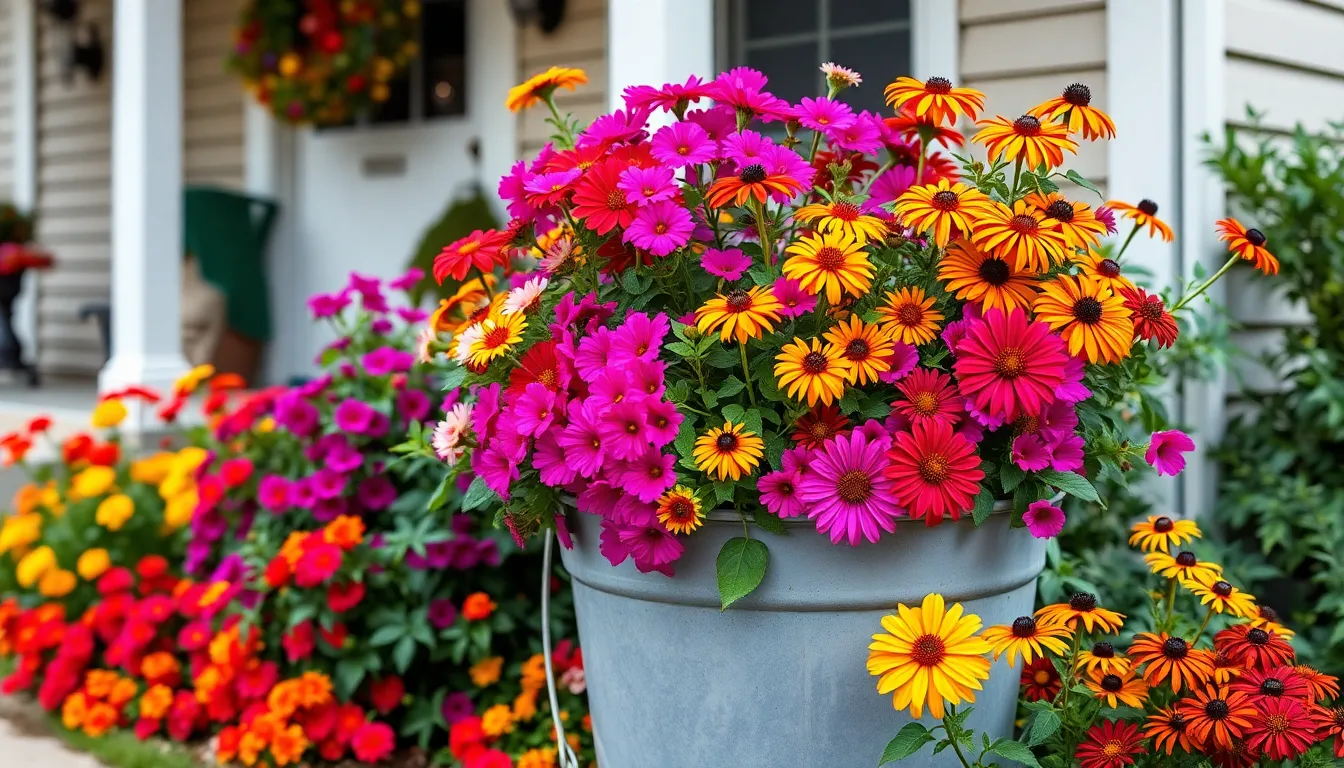
Transforming our home’s exterior with vibrant bucket flower gardens creates instant visual impact while maintaining the practical benefits we’ve discovered in vegetable gardening. Proper bucket preparation remains essential—we’ll use 5-gallon food-grade containers with drainage holes and well-draining potting mix for optimal flower growth.
Choose Colorful Annual Flowers
Annuals deliver vibrant seasonal color that transforms our curb appeal throughout the growing season. Petunias cascade beautifully over bucket edges, creating stunning displays in purple, pink, white, and yellow varieties. Marigolds provide bold orange and yellow blooms while naturally deterring garden pests from nearby plants.
Zinnias offer exceptional value with their long-lasting flowers and easy care requirements. These reliable performers produce continuous blooms in red, orange, pink, and white from summer through frost. We can change our annual selections each season, giving us fresh looks and preventing visual monotony in our industry design.
Mixing different annual varieties in single buckets creates ever-changing color combinations. Combining tall zinnias with trailing petunias and compact marigolds produces layered arrangements that maximize visual interest. This approach allows us to experiment with color schemes and discover combinations that complement our home’s exterior.
Plant Perennial Flowers for Long-Term Beauty
Perennials provide consistent beauty year after year, making them cost-effective investments for our bucket gardens. Coneflowers (Echinacea) produce stunning purple, pink, and white blooms that attract butterflies and beneficial insects to our industry. These hardy plants return stronger each season, requiring minimal maintenance once established.
Black-eyed Susans deliver cheerful yellow flowers from midsummer through fall. Their bright golden petals with dark centers create classic cottage garden charm in our bucket displays. These drought-tolerant perennials thrive in various conditions and spread naturally to fill containers over time.
Daisies bring timeless appeal with their simple white petals and sunny yellow centers. Shasta daisies work particularly well in bucket gardens, reaching 2-3 feet in height and blooming repeatedly throughout the season. We can divide established clumps every few years to create additional plants for expanding our displays.
Create Seasonal Flower Arrangements
Spring arrangements kickstart our growing season with early-blooming favorites. Tulips provide elegant cup-shaped flowers in vibrant reds, yellows, and purples after winter’s dormancy. Daffodils offer reliable yellow and white blooms that naturalize over time, while pansies deliver cheerful faces in cool weather conditions.
Summer displays feature bold, heat-loving flowers that thrive in warm weather. Sunflowers create dramatic focal points with their towering stems and massive yellow blooms reaching 6-8 feet in height. Cosmos produce delicate, daisy-like flowers in pink, white, and orange that dance in summer breezes.
Fall arrangements extend our gardening season with autumn-exact varieties. Chrysanthemums provide classic fall colors in bronze, burgundy, and gold that complement seasonal decorations. Asters offer purple and white star-shaped flowers that bloom just as summer varieties fade.
Winter displays maintain interest during dormant months using evergreen elements. Evergreen branches from pine, fir, or cedar create structural foundation for cold-season arrangements. Cyclamen add unexpected color with their delicate pink, white, and red flowers that actually prefer cooler temperatures for optimal blooming.
Create Self-Watering Bucket Garden Systems
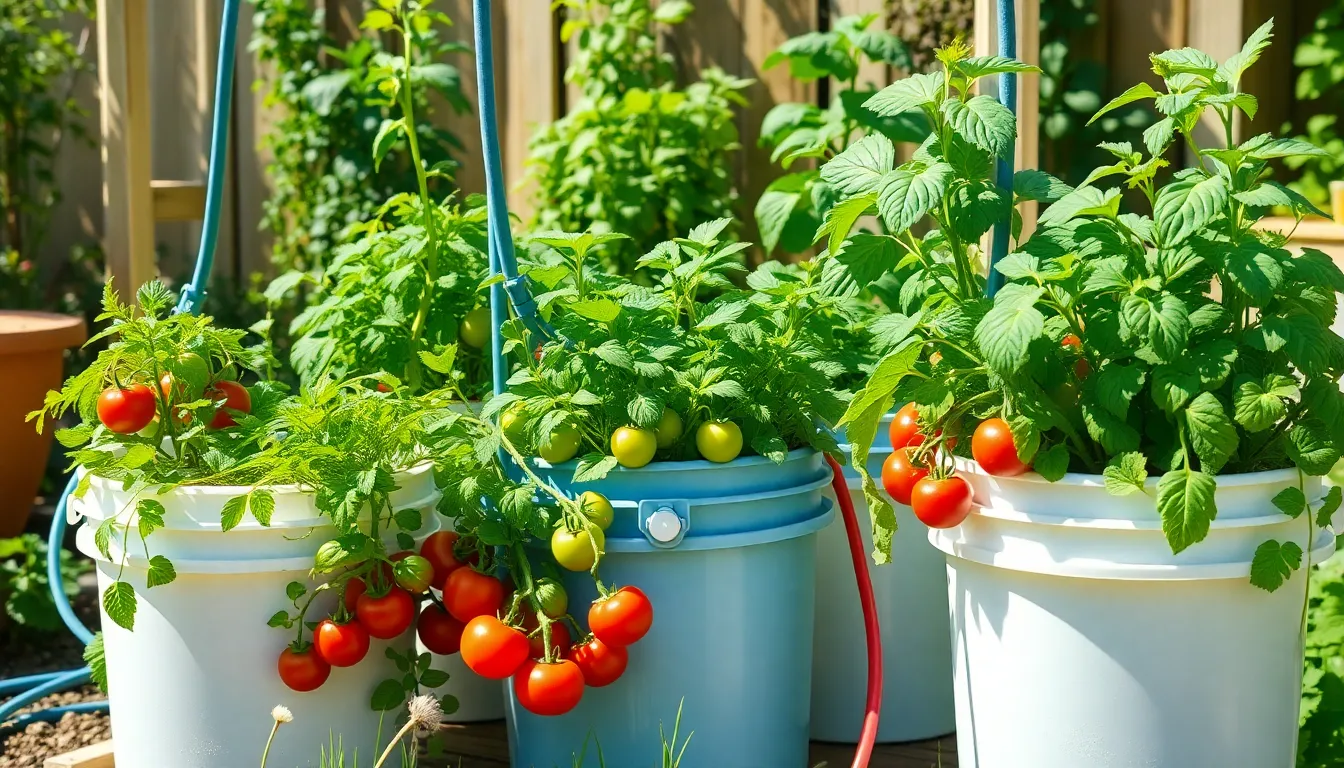
Self-watering bucket systems revolutionize our gardening approach by reducing maintenance while ensuring consistent plant hydration. These innovative setups eliminate the guesswork from watering schedules and help our plants thrive even during busy periods.
Build Simple Reservoir Systems
Simple reservoir systems offer the most straightforward approach to self-watering bucket gardens. We can create these systems using either a single bucket or a two-bucket setup depending on our exact needs.
Single Bucket Method: Start by drilling several small holes in the bottom of your bucket to allow water seepage into the soil. Place a wicking cup filled with soil in a hole at the bottom of the growing chamber to help water uptake. This method works exceptionally well for herbs and smaller vegetables.
Two Bucket Setup: Position the bottom bucket as our water reservoir while the top bucket contains the growing medium. Drill holes in the bottom of the top bucket to enable water wicking from the reservoir below. This system provides longer-lasting hydration for larger plants like tomatoes and peppers.
Install Drip Irrigation Methods
Drip irrigation methods bring precision watering directly to our bucket gardens. We can adapt traditional drip systems for container use by installing drip lines within each bucket.
Placement Strategy: Insert drip lines directly into the soil near plant roots to deliver water exactly where it’s needed most. This targeted approach reduces water waste through evaporation and runoff significantly.
Timer Integration: Connect our drip system to automatic timers for consistent watering schedules. Set intervals based on plant needs and seasonal changes to maintain optimal soil moisture levels throughout the growing season.
Use Moisture-Wicking Techniques
Moisture-wicking techniques ensure even water distribution throughout our bucket gardens using specialized materials. We can incorporate various wicking materials to maintain consistent hydration levels.
Material Selection: Use perlite or cloth strips as wicking agents to absorb and distribute water evenly through the soil. These materials help prevent both overwatering and dry spots within our containers.
Wicking Cup Installation: Place a wicking cup filled with soil below the waterline in our reservoir systems. This setup keeps some soil constantly moist while allowing plants to draw water as needed through natural capillary action.
Distribution Network: Create a network of wicking materials throughout the soil to ensure all plant roots have access to consistent moisture. This technique works particularly well for densely planted herb buckets and leafy green containers.
Establish Portable Bucket Gardens for Renters
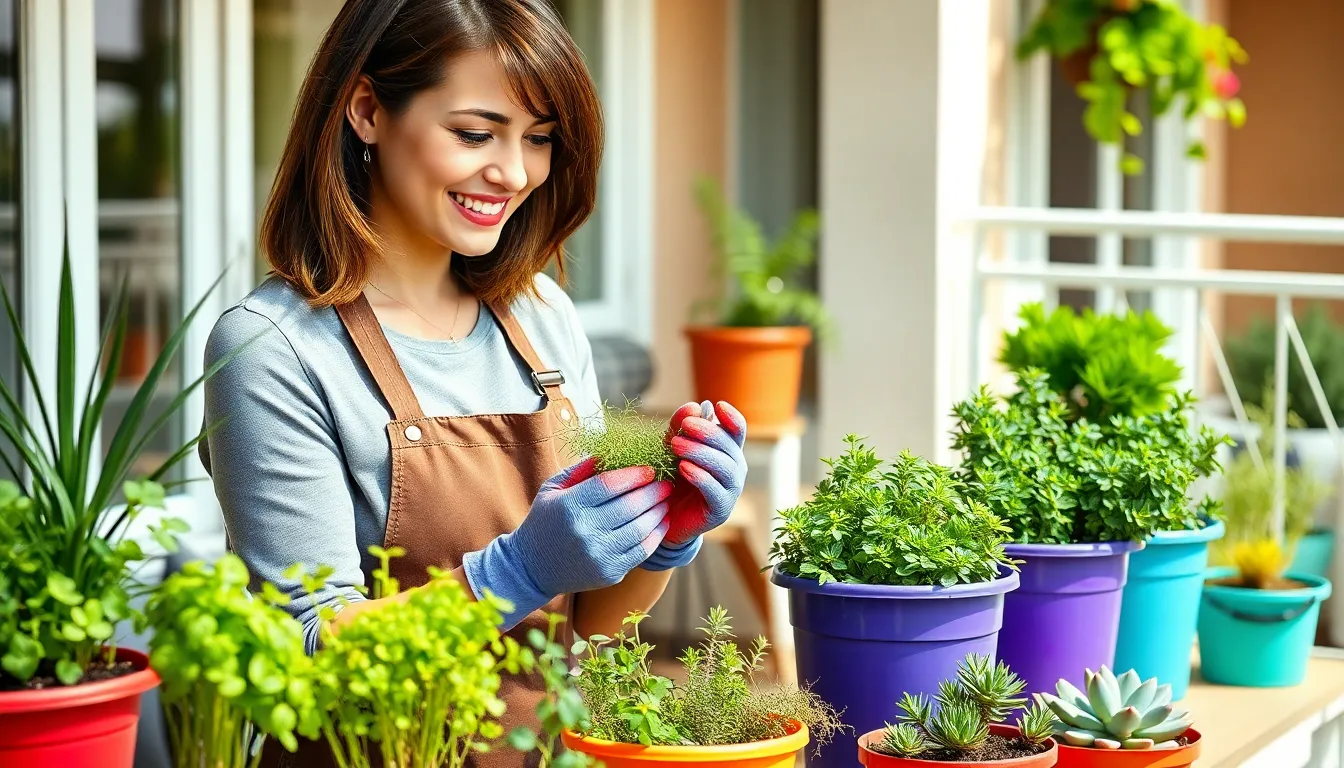
Rental living doesn’t mean sacrificing your gardening dreams. We’ll help you create a thriving bucket garden that can easily move with you from apartment to apartment.
Select Lightweight Bucket Materials
Plastic buckets offer the best solution for renters who need gardens they can transport effortlessly. These containers weigh significantly less than ceramic or concrete alternatives, making them perfect when you’re loading a moving truck or rearranging your patio space.
Repurposed buckets add character while keeping costs down for budget conscious renters. Old paint buckets, food grade containers, and even large yogurt tubs can become unique planters that reflect your personal style. Clean these containers thoroughly before planting to ensure your plants get the healthiest start possible.
Food grade plastic buckets provide the safest option for growing edible plants like herbs and vegetables. We recommend choosing buckets with recycling codes 1, 2, 4, or 5 to avoid harmful chemicals leaching into your soil.
Choose Plants That Handle Movement Well
Succulents thrive even though irregular watering schedules that often accompany busy moving periods. These hardy plants store water in their leaves and stems, allowing them to survive if you forget to water them during hectic transition times.
Herbs like rosemary, thyme, and mint adapt quickly to new environments and lighting conditions. These resilient plants bounce back from the stress of relocation faster than most other garden varieties, ensuring your cooking ingredients stay fresh even after a move.
Houseplants such as snake plants, spider plants, pothos, and ZZ plants tolerate changing light conditions better than traditional outdoor flowers. We’ve found these varieties particularly useful for renters who might move from sunny balconies to shadier patios.
Fast growing herbs like basil and cilantro recover quickly from transplant shock, giving you fresh ingredients within weeks of settling into your new home.
Design Easy-to-Move Garden Layouts
Tiered plant stands maximize space while keeping individual buckets accessible for quick transport. We suggest using lightweight metal or plastic stands that can be disassembled easily when it’s time to relocate.
Hanging pocket planters mount temporarily to railings or walls without permanent hardware, making them ideal for rental properties. These vertical answers save floor space and can be packed flat for moving day storage.
Modular wall systems assemble and disassemble in minutes, allowing you to recreate your garden layout in any new space. Look for systems with lightweight panels that connect without tools or permanent mounting brackets.
Rolling carts transform stationary gardens into mobile growing stations that follow the sun throughout the day. Choose carts with locking wheels to prevent your garden from rolling away during windy weather.
Grouped cluster arrangements make it easier to move your entire garden setup by keeping related plants together in manageable sections.
Develop Specialty Bucket Gardens for Unique Needs
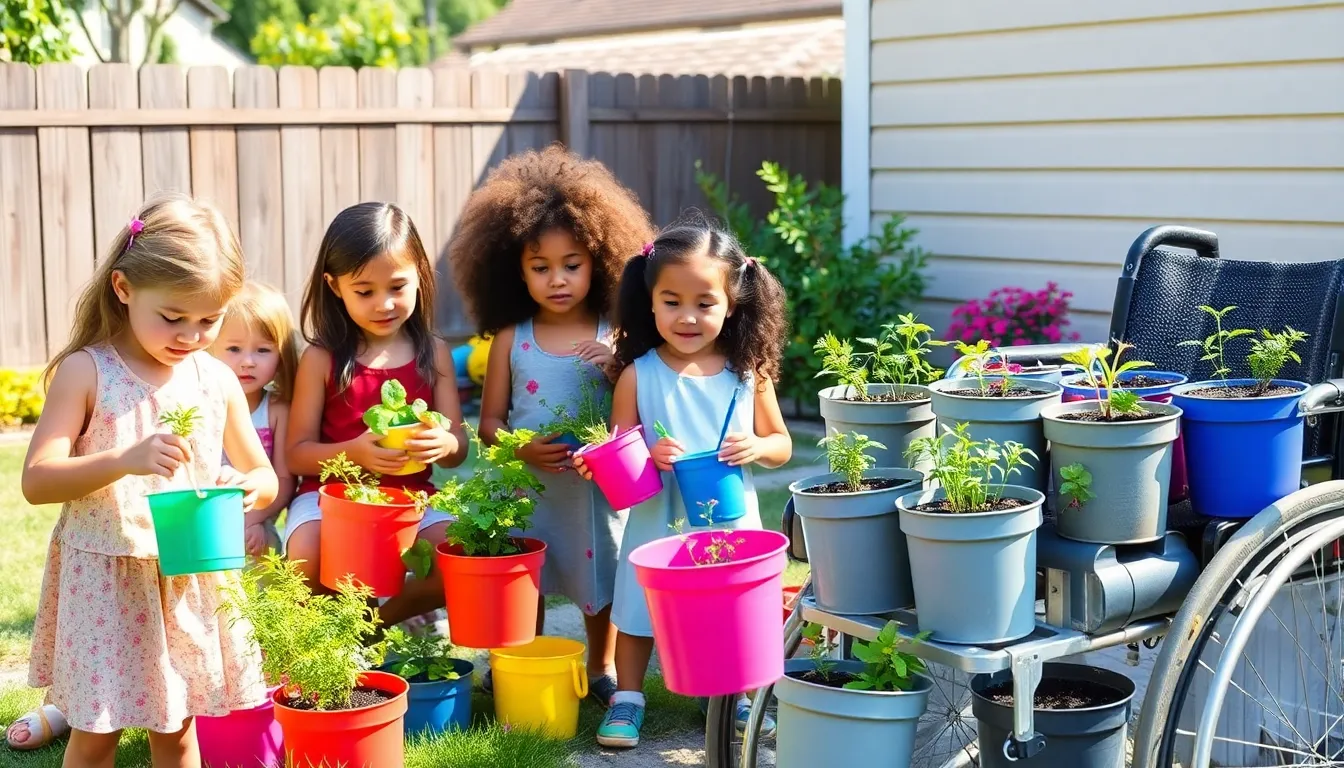
We’ve explored traditional bucket gardening approaches, but specialty gardens address exact needs and circumstances that standard container gardens can’t fulfill. Customizing our bucket gardens for unique situations opens doors to innovative growing answers.
Create Kid-Friendly Garden Projects
Kids thrive when they’re actively involved in hands-on planting experiences that spark their curiosity about nature. We recommend starting with small buckets that children can easily handle and decorate with non-toxic paints or colorful stickers before planting begins.
Educational gardens teach children about different plant species through interactive bucket displays. Fast-growing plants like radishes, lettuce, and bean sprouts provide quick results that maintain young gardeners’ interest and enthusiasm.
Miniature theme gardens capture children’s imagination using 2-gallon buckets to create fairy gardens with tiny plants like baby’s tears and small succulents. Pirate-themed gardens can feature herbs like parsley (representing seaweed) and cherry tomatoes (treasure), making gardening feel like an adventure rather than a chore.
Sensory bucket gardens engage multiple senses by incorporating plants with different textures, scents, and colors. Lamb’s ear provides softness, mint offers fragrant leaves to touch, and purple basil adds visual interest that children love to explore.
Build Wheelchair-Accessible Gardens
Wheelchair users benefit from bucket gardens placed on raised platforms or tables that eliminate the need for bending or reaching down to ground level. We suggest positioning buckets at heights between 24-36 inches to ensure comfortable access for most wheelchair users.
Wide pathways measuring at least 36 inches provide adequate space for wheelchair navigation around bucket garden displays. Non-slip surfaces prevent accidents and ensure safe movement throughout the growing area.
Lightweight containers make it easier for wheelchair users to manage their gardens independently. We recommend 3-gallon plastic buckets filled with lightweight potting mix rather than heavy soil for plants that don’t require extensive root systems.
Tabletop bucket arrangements allow wheelchair gardeners to bring plants closer for detailed care and harvesting. Rolling tables provide additional flexibility, letting gardeners move their bucket displays to follow sunlight or create better access angles.
Design Indoor Bucket Gardens
Indoor herb gardens flourish on windowsills using 1-2 gallon buckets filled with well-draining potting mix. Basil, mint, oregano, and chives adapt well to indoor conditions and provide fresh ingredients year-round for cooking.
Self-watering systems reduce maintenance requirements for indoor bucket gardens by incorporating water reservoirs that feed plants gradually. We create these systems using a smaller bucket nested inside a larger one, with wicking material drawing moisture upward as needed.
Decorative displays transform functional growing containers into attractive home décor elements. We use ceramic or painted metal buckets that complement interior design while housing low-maintenance plants like pothos, snake plants, or small succulents.
Natural lighting considerations determine plant placement and species selection for indoor bucket gardens. South-facing windows provide the brightest light for sun-loving herbs, while north-facing locations work better for shade-tolerant plants like lettuce or spinach.
Air circulation prevents fungal problems that commonly affect indoor container gardens. We position small fans nearby or ensure adequate spacing between buckets to promote healthy airflow around our indoor growing systems.
Maintain and Troubleshoot Your Bucket Gardens
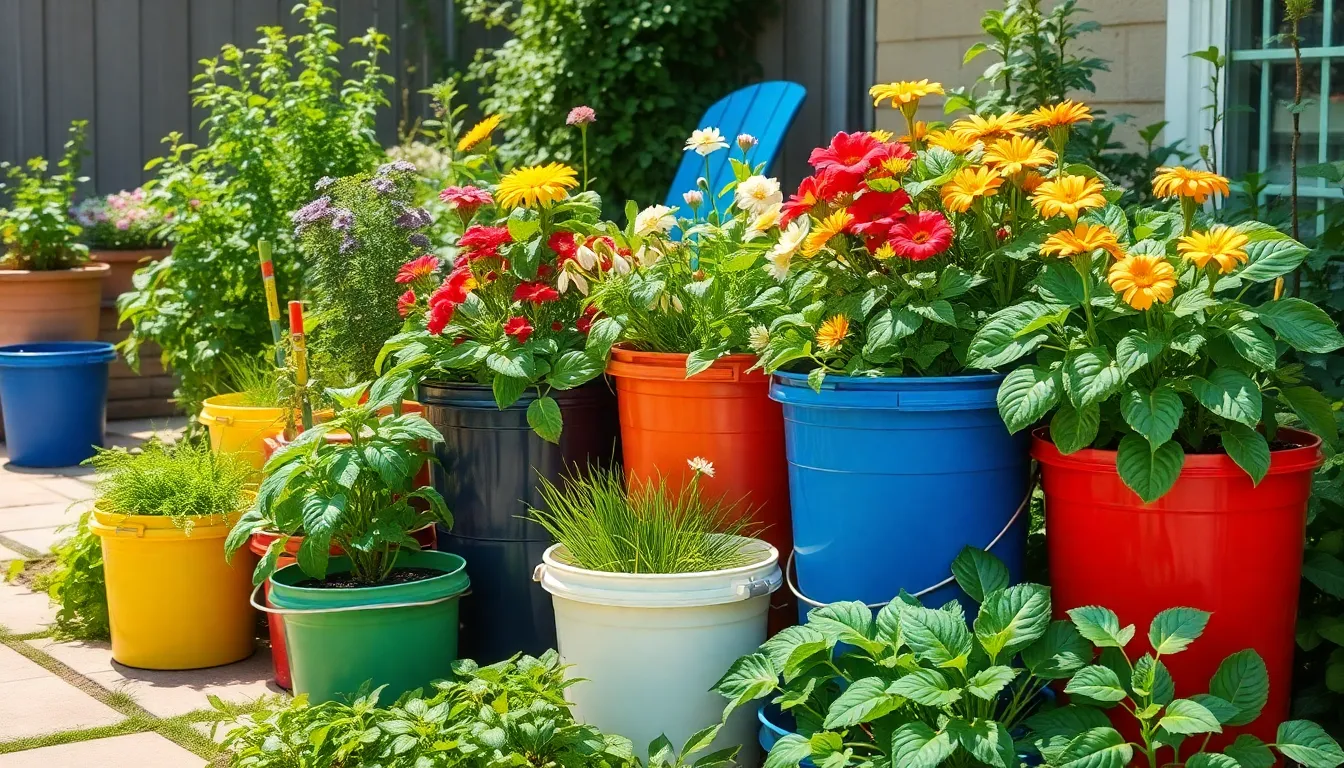
Successful bucket gardens require ongoing care and attention to thrive throughout the growing season. We’ll help you establish effective maintenance routines that keep your plants healthy and productive.
Provide Proper Fertilization Schedules
Apply balanced fertilizers containing equal ratios of nitrogen, phosphorus, and potassium to support overall plant health. We recommend using 10-10-10 NPK fertilizer every 2-3 weeks during the active growing season for most vegetables and flowers.
Feed container plants more frequently than traditional garden plants since nutrients wash away faster through drainage holes. Dilute liquid fertilizer to half strength and apply weekly rather than using full-strength monthly applications.
Choose organic fertilizer options like compost tea or fish emulsion for sustainable plant nutrition. Mix compost tea by steeping finished compost in water for 24-48 hours, then strain and apply to soil around plant bases.
Time fertilizer applications according to each plant’s growth stage and seasonal needs. Start feeding young plants with quarter-strength fertilizer, increase to half-strength during vegetative growth, and reduce feeding as plants approach harvest time.
Prevent Common Pest Problems
Inspect plants regularly by checking both upper and lower leaf surfaces for early signs of aphids, whiteflies, or spider mites. We examine our bucket gardens weekly during morning hours when pest activity is most visible.
Use natural pest control remedies that won’t harm beneficial insects visiting your garden. Apply neem oil spray every 7-10 days as a preventive measure, or treat active infestations with insecticidal soap answers.
Encourage beneficial insects by planting companion flowers like marigolds, nasturtiums, and sweet alyssum in nearby buckets. These natural pest deterrents attract ladybugs, lacewings, and parasitic wasps that control harmful insects.
Remove affected plant material immediately when you notice pest damage or disease symptoms. Dispose of infected leaves and stems in household waste rather than compost to prevent spreading problems to healthy plants.
Manage Watering and Drainage Issues
Create adequate drainage systems by drilling 4-6 holes measuring ½ inch diameter in bucket bottoms to prevent waterlogged soil and root rot. Place buckets on pot feet or bricks to improve airflow underneath containers.
Monitor soil moisture levels by inserting your finger 2 inches deep into potting mix before watering. Water thoroughly when soil feels dry at this depth, allowing excess water to drain completely from bottom holes.
Install efficient watering methods like drip irrigation systems or sub-irrigation setups to conserve water and reduce evaporation. These techniques deliver water directly to root zones while keeping foliage dry and disease-free.
Adjust watering frequency based on weather conditions, plant size, and seasonal changes. Water bucket gardens daily during hot summer weather, reduce to every 2-3 days during cooler periods, and check soil moisture more frequently for newly transplanted seedlings.
Conclusion
Bucket gardening opens up endless possibilities for anyone wanting to grow their own plants regardless of space or budget constraints. We’ve shown you how these simple containers can transform into thriving herb gardens vertical displays productive vegetable plots and stunning flower arrangements.
Whether you’re a renter looking for portable answers or someone seeking low-maintenance growing systems bucket gardens adapt to your unique needs. From kid-friendly projects to wheelchair-accessible designs these versatile containers make gardening inclusive and enjoyable for everyone.
With proper maintenance techniques and creative design ideas you’re now equipped to start your own bucket garden adventure. Remember that success comes from consistent care and experimentation so don’t hesitate to try different plants and arrangements until you find what works best for your space.
Frequently Asked Questions
What is bucket gardening and who is it best for?
Bucket gardening is a container gardening method using buckets to grow plants in small spaces. It’s perfect for renters, apartment dwellers, or anyone with limited yard space, poor soil quality, or budget constraints. You can set up bucket gardens on balconies, patios, or even indoors, making it accessible for virtually anyone wanting to grow their own plants.
What size buckets should I use for different types of herbs?
For herbs, use 5-gallon buckets for large varieties like rosemary, 3-gallon containers for medium herbs like basil, and 1-2 gallon buckets for compact herbs like thyme. Fast-growing herbs such as basil, cilantro, and chives work best for quick results. Always ensure proper drainage by drilling holes in the bottom of your containers.
How can I maximize space with vertical bucket gardening?
Use three main techniques: stack buckets with PVC pipe systems for stability, create hanging arrangements for lightweight plants to save floor space, or design tiered displays for visual appeal. These methods help you grow more plants in limited areas while maintaining easy access for care and harvesting.
Can I grow vegetables in 5-gallon buckets successfully?
Yes! Cherry and patio tomatoes work excellently with one plant per bucket. Peppers and eggplants also thrive in buckets, benefiting from warmer soil temperatures. For root vegetables like carrots and radishes, you can plant multiple plants per bucket due to their shallow root systems. Always provide support structures for taller plants.
What flowers work best in bucket gardens?
Choose colorful annuals like petunias, marigolds, and zinnias for vibrant seasonal displays. For long-term beauty, select perennials such as coneflowers, black-eyed Susans, and daisies. Use 5-gallon food-grade containers with proper drainage and quality potting mix. Plan seasonal arrangements to maintain year-round visual appeal in your garden.
How do I create a self-watering bucket system?
Build a reservoir system using either single or double bucket setups with water wicking materials. Install drip irrigation for precise watering or use moisture-wicking techniques for even water distribution. These systems reduce maintenance while ensuring consistent plant hydration, making bucket gardening more efficient and successful during busy periods.
Are bucket gardens suitable for renters?
Absolutely! Use lightweight plastic buckets that are easy to transport when moving. Repurpose old containers for unique planters, ensuring food-grade plastic for edibles. Choose resilient plants like succulents and herbs that handle movement well. Design portable layouts with tiered stands, rolling carts, or modular systems for easy relocation.
How do I maintain healthy bucket gardens?
Follow proper fertilization schedules using balanced or organic fertilizers. Conduct regular pest inspections and use natural remedies when needed. Ensure effective watering and drainage to prevent root rot. Monitor plants consistently throughout the growing season, adjusting care as needed to maintain healthy, productive bucket gardens year-round.

